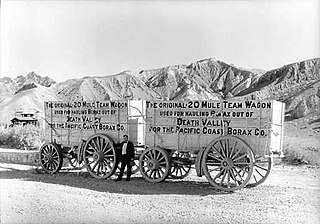
Amargosa Valley is an unincorporated town located on U.S. Route 95 in Nye County, in the U.S. state of Nevada.

Death Valley Junction, more commonly known as Amargosa, is a tiny Mojave Desert unincorporated community in Inyo County, California, at the intersection of SR 190 and SR 127, in the Amargosa Valley and just east of Death Valley National Park. The zip code is 92328, the elevation is 2,041 ft (622 m), and the population is fewer than four people.

The Tonopah and Tidewater Railroad was a former class II railroad that served eastern California and southwestern Nevada.

Francis Marion Smith was an American miner, business magnate and civic builder in the Mojave Desert, the San Francisco Bay Area, and Oakland, California. He was known nationally and internationally as "Borax Smith" and "The Borax King", as his company produced the popular 20-Mule-Team Borax brand of household cleaner.

The Pacific Coast Borax Company (PCB) was a United States mining company founded in 1890 by the American borax magnate Francis Smith, the "Borax King".

The Death Valley Railroad (DVRR) was a 3 ft narrow-gauge railroad that operated in California's Death Valley to carry borax with the route running from Ryan, California, and the mines at Lila C, both located just east of Death Valley National Park, to Death Valley Junction, a distance of approximately 20 miles (32 km).

The Amargosa Desert is located in Nye County in western Nevada, United States, along the California–Nevada border, comprising the northeastern portion of the geographic Amargosa Valley, north of the Ash Meadows National Wildlife Refuge.

The Borate and Daggett Railroad was a 3 ft narrow gauge railroad built to carry borax in the Mojave Desert. The railroad ran about 11 miles (18 km) from Daggett, California, US, to the mining camp of Borate, three miles (4.8 km) to the east of Calico.
Ludlow is an unincorporated community in the Mojave Desert on Interstate 40, located in San Bernardino County, California, United States. The older remains of the ghost town are along historic Route 66.

The Oasis at Death Valley, formerly called Furnace Creek Inn and Ranch Resort, is a luxury resort in Furnace Creek, on private land within the boundaries of California's Death Valley National Park. It is owned and operated by Xanterra Travel Collection.

The Las Vegas and Tonopah Railroad was a 197.9-mile (318.5 km) railroad built by William A. Clark that ran northwest from a connection with the mainline of the San Pedro, Los Angeles, and Salt Lake Railroad at Las Vegas, Nevada to the gold mines at Goldfield. The SPLA&SL railroad later became part of the Union Pacific Railroad and serves as their mainline between Los Angeles and Salt Lake City.

The Bullfrog Hills are a small mountain range of the Mojave Desert in southern Nye County, southwestern Nevada. Bullfrog Hills was so named from a fancied resemblance of its ore to the color of a bullfrog.
Lila C is a former settlement in Inyo County, California. It was located 6.25 miles (10 km) southwest of Death Valley Junction, at an elevation of 2562 feet.

Ryan is an unincorporated community in Inyo County, California that is now privately owned and stewarded by the Death Valley Conservancy. A former mining community and company town, Ryan is situated at an elevation of 3,045 feet (928 m) in the Amargosa Range, 8 miles (13 km) northeast of Dante's View and 15 miles (24 km) southeast of Furnace Creek.
Gerstley is a former settlement in Inyo County, California.

Amargosa Opera House and Hotel is a historic building and cultural center located in Death Valley Junction, in eastern Inyo County, California near Death Valley National Park.
Richard C. Baker was the British business partner of Francis Marion "Borax" Smith and eventually became president of the Pacific Coast Borax Company and the Tonopah and Tidewater Railroad.
Leeland is a former railway hamlet in the Amargosa Valley in Nye County, Nevada. A year after its founding in 1906, a railway station was opened. Raw materials from the nearby Californian mining village Lee were brought to Leeland to be transported by train.

The Pittman Underground Water Act was an Act of Congress, that was approved on October 22, 1919 and was repealed on August 11, 1964. The public law gave the Secretary of the Interior the power to hand out permits to American citizens and associations to drill for and look for groundwater on public lands in Nevada. In addition, the law gave the Secretary the power to give patents to permittees who found enough groundwater to sustain a farm. The law was supposed to stimulate agriculture in Nevada by supporting the development of artesian waters, since it was thought that the absence of surface water undermined the growth of the agricultural sector in Nevada.

The Bullfrog Goldfield Railroad (BGRR) was a railroad lying just inside and about midway of the southwestern State line of Nevada. It was incorporated in 1905 to provide an outlet from the mining section near Beatty to the north over the lines of the Tonopah and Goldfield Railroad and the Southern Pacific Railroad.


















